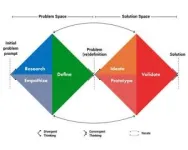(Press-News.org) While Food is Medicine programs are successfully helping patients manage their health, many initiatives are small-scale pilots, providing treatment to several hundred or several thousand patients. Results of these studies have demonstrated that these nutrition-based food prescription programs improve a range of health outcomes for patients with diet-sensitive conditions, while also potentially saving in medical costs, suggesting wider implementation and investment would lead to long-term savings and a healthier population.
To quantify the potential impact of one such intervention, a team at the Food is Medicine Institute at the Gerald J. and Dorothy R. Friedman School of Nutrition Science and Policy at Tufts University developed a simulation model to predict how medically tailored meals—designed by registered dieticians to meet the nutritional needs of individuals with complex health conditions—would affect patients and health care systems across all 50 states.
Their analysis, published April 7 in the journal Health Affairs, estimated that nationwide implementation could save approximately $32.1 billion in health care costs in the first year alone and prevent more than 3.5 million hospitalizations annually related to complications from diabetes, heart disease, and cancer.
“The most striking finding is that medically tailored meals, assuming full uptake by eligible individuals, were cost saving in 49 of 50 states, highlighting their potential to reduce both financial and health burdens,” said first author Shuyue (Amy) Deng, a doctoral student at the Friedman School. “These results emphasize the potential for policymakers to integrate medically tailored meals into health care coverage at scale.”
The simulation was run 1,000 times to account for uncertainties. The state-by-state analysis showed a net health and cost benefit for medically tailored meal programs nationwide, with important variations based on each state’s health care costs, infrastructure, policies, hospitalization patterns, and rates of diet-sensitive conditions. Among all states, Connecticut showed the highest annual per-patient savings at $6,299, followed by Pennsylvania ($4,450) and Massachusetts ($4,331). Alabama was the only state where implementing medically tailored meals would be cost-neutral but still yield health benefits for residents.
The researchers estimated that more than 14 million Americans across the country would qualify for receiving medically tailored meals—from as high as 1,221,000 in California to 18,000 in Alaska—based on having both a diet-sensitive condition like diabetes, cardiovascular diseases, or cancer and limitations in day-to-day activities, such as preparing meals or going shopping. Among this population, the model calculated that the average annual health care expenditure is around $30,900 per person, with each person experiencing an average of 0.53 hospitalizations per year.
The simulation model also evaluated how many patients would need to receive medically tailored meals to prevent one hospitalization. Maryland required the fewest (2.3 patients), and Colorado required the most (6.9 patients). The reasons for state-to-state differences varied, impacted by factors ranging from the health of each state’s population to the infrastructure of their hospital payment systems. Nationally, these programs were estimated to avert over 3.5 million hospitalizations annually.
"Our findings suggest that medically tailored meals are not just good medicine—they're good economics," said senior author Dariush Mozaffarian, director of the Food is Medicine Institute at the Friedman School. "States are excellent incubators for health care innovation. Investing in medically tailored meals could transform care for vulnerable patients in every state while creating substantial health care value."
Of the people considered in the simulation model, nearly 90% were covered by Medicare and Medicaid services, and the rest by private insurers. As of January 2025, 16 states have approved or proposed Medicaid section 1115 waivers (special permissions to test new health innovations) to cover Food is Medicine treatments, which can include pilots for medically tailored meals. Further considerations will be needed to scale effectively, such as training providers, integrating screening and referral tools into the electronic health records, and ensuring taste and nutritional quality of the meals.
This study is one of six papers including Food is Medicine Institute experts appearing in a recent issue of Health Affairs with a theme of food, nutrition, and health. The other five papers are:
Food is Medicine in America: A national poll of public perceptions of care, practices, and policies
Complex Interrelationships between Income, Food Security, Nutrition Security, and Health
Advancing FDA's Human Food Program Through Additional Authorities and User Fees
Medicaid Flexible Services to Address Nutritional Needs: Impacts on Healthcare Utilization and Costs in Massachusetts
Use of Medicaid Managed Care In Lieu of Services to Address Poor Nutrition in the U.S.
Research reported in this article was supported by the National Institutes of Health under award numbers R01HL115189, R01DK134452, and R01MD019094. Complete information on authors, methodology and conflicts of interest is available in the published paper. The content is solely the responsibility of the authors and does not necessarily represent the official views of the National Institutes of Health.
END
Medically tailored meal programs could yield significant health care savings across 49 US states
Simulation predicts that prescriptions for foods tailored to support millions of Americans with diet-sensitive conditions would reduce related expenses
2025-04-07
ELSE PRESS RELEASES FROM THIS DATE:
Sarah Sjöström, MSN, RN, ACNP-BC, named chief nursing officer at Hebrew SeniorLife
2025-04-07
Sarah Sjöström, MSN, RN, ACNP-BC, has been promoted to chief nursing officer at Hebrew SeniorLife.
Sjöström joined Hebrew SeniorLife in 2010 as a staff nurse, later became director of nursing in the Medical Acute Care Unit, was promoted to associate chief nursing officer in 2017, and gained the vice president of ancillary services responsibilities in 2023.
She is co-chair of Hebrew SeniorLife’s Age-Friendly Committee and, through that work and as associate chief nursing officer, has championed quality of care and age-friendly practices across the organization. In 2021, she received a John A. Hartford Foundation scholarship to participate in the ...
Transparency in government is good for global health
2025-04-07
When are you most forthcoming with life updates? And when are you the most transparent about exactly what those updates are? For most folks — show of hands, please — it’s when things are going well. Sharing our wins is in our nature; our losses, typically, not so much.
Not surprisingly, governments are similarly inclined. Yet, it turns out, broad government transparency not only breeds goodwill, begetting still more transparency — it can change lives for the better.
Researchers Sarah Anderson and Mark Buntaine, of UC Santa Barbara’s Bren School of Environmental Science & Management, and colleagues ...
Dust in the Wind: How cities alter natural airborne particles
2025-04-07
Airborne dust pollution is a growing problem for residente of Utah and other Western states, especially with the exposed lakebed of Great Salt Lake potentially becoming more hazardous as the lake dries. Natural dust blows from the Great Basin and settles along the western edge of the Wasatch Front, Utah’s major population center, and the surrounding mountains. While airborne, the dust mixes with local human-made materials, potentially contaminating the nearby watershed and resulting in other negative consequences, according ...
Stephen Hauser wins breakthrough prize for role in redefining MS
2025-04-07
Stephen Hauser Wins Breakthrough Prize for Role in Redefining MS
UCSF luminary played a pivotal part in identifying cause of multiple sclerosis, leading to a new generation of game-changing therapies.
Neuro-immunologist Stephen Hauser, MD, whose maverick thinking transformed the treatment landscape for patients with multiple sclerosis (MS), has received the 2025 Breakthrough Prize in Life Sciences.
Hauser, a UCSF professor of neurology and director of the Weill Institute for Neurosciences, was recognized April 5 for overturning ...
Childhood experiences shape the brain’s white matter with cognitive effects seen years later
2025-04-07
Mass General Brigham investigators have linked difficult early life experiences with reduced quality and quantity of the white matter communication highways throughout the adolescent brain. This reduced connectivity is also associated with lower performance on cognitive tasks. However, certain social resiliency factors like neighborhood cohesion and positive parenting may have a protective effect. Results are published in Proceedings of the National Academy of Sciences (PNAS).
White matter are the communication highways that allow the brain networks to carry out the necessary functions for cognition and behavior. ...
Hantavirus in Madagascar linked to black rats in agricultural areas
2025-04-07
Invasive species cause environmental mayhem when they establish themselves in a new ecosystem. But these interlopers can also impact human health directly. Deadly diseases can jump from animals to humans, as the COVID-19 pandemic vividly illustrated.
A new study led by researchers at UC Santa Barbara, University of Réunion and Duke University reveals that the black rat is likely responsible for transmitting the deadly hantaviruses in rural Madagascar, where forested landscapes have been converted to agriculture and settlements. The results appear in the journal Ecology and Evolution.
Rats have been familiar ...
Clockwork, just for antibiotic resistance?
2025-04-07
Could a gene regulatory network in gut microbes have evolved its elaborate and tightly regulated molecular machinery only to pump out antibiotics indiscriminately? Researchers from the Institute of Science and Technology Austria (ISTA) show this is an auxiliary function. By maintaining basal levels of genetic activity when the network is in its OFF state, these genes ensure the bacteria remain fit and adaptable to their highly variable environment in the gut. The findings were published in PNAS.
This is the story of a misnomer. And an immense and intricate molecular machinery at that, ...
Tabbye M. Chavous named new Executive Director of the American Educational Research Association
2025-04-07
Washington, April 7, 2025—The American Educational Research Association (AERA) is pleased to announce the appointment of Tabbye M. Chavous as its new executive director, effective August 11, 2025. A nationally recognized scholar and seasoned leader, Chavous brings over 25 years of experience and significant accomplishments in research, teaching, and organizational advancement. Across her career, she has consistently advocated for high-quality, inclusive research, and her equity-oriented leadership is evident in her approaches to building and transforming educational environments.
Chavous succeeds Felice J. Levine, who has served as executive director ...
Mindfulness and cognitive behavioral therapy improve chronic low back pain
2025-04-07
HERSHEY, Pa. — The list of treatments for low back pain is endless, but few offer relief for the one in four Americans who suffer from this persistent pain and leading cause of disability globally. More than 80% of those with chronic low back pain wished there were better treatment options. Yet, without sufficient pain relief, many people need to take opioids, which can be addictive.
The good news? A multi-institutional team, led by researchers from the Penn State College of Medicine and the University of Wisconsin-Madison, found that eight weeks of either mindfulness or cognitive behavioral ...
Proteins shown to act as ‘guardians’ to keep cells’ energy making mitochondria safe
2025-04-07
Scientists at Johns Hopkins Medicine say they have discovered how a group of proteins linked to Parkinson’s disease and amyotrophic lateral sclerosis act as “guardians” of mitochondria, small organelles, or subunits, within a cell that make and store energy and are found in almost all plants and animals.
The findings, resulting from experiments with genetically engineered mice should advance understanding of the development of Parkinson’s disease — a chronic and progressive neurodegenerative disorder whose causes are not clearly known — the scientists say. Most experts believe Parkinson’s disease is a result of some combination ...
LAST 30 PRESS RELEASES:
Making lighter work of calculating fluid and heat flow
Normalizing blood sugar can halve heart attack risk
Lowering blood sugar cuts heart attack risk in people with prediabetes
Study links genetic variants to risk of blinding eye disease in premature infants
Non-opioid ‘pain sponge’ therapy halts cartilage degeneration and relieves chronic pain
AI can pick up cultural values by mimicking how kids learn
China’s ecological redlines offer fast track to 30 x 30 global conservation goal
Invisible indoor threats: emerging household contaminants and their growing risks to human health
Adding antibody treatment to chemo boosts outcomes for children with rare cancer
Germline pathogenic variants among women without a history of breast cancer
Tanning beds triple melanoma risk, potentially causing broad DNA damage
Unique bond identified as key to viral infection speed
Indoor tanning makes youthful skin much older on a genetic level
Mouse model sheds new light on the causes and potential solutions to human GI problems linked to muscular dystrophy
The Journal of Nuclear Medicine ahead-of-print tip sheet: December 12, 2025
Smarter tools for peering into the microscopic world
Applications open for funding to conduct research in the Kinsey Institute archives
Global measure underestimates the severity of food insecurity
Child survivors of critical illness are missing out on timely follow up care
Risk-based vs annual breast cancer screening / the WISDOM randomized clinical trial
University of Toronto launches Electric Vehicle Innovation Ontario to accelerate advanced EV technologies and build Canada’s innovation advantage
Early relapse predicts poor outcomes in aggressive blood cancer
American College of Lifestyle Medicine applauds two CMS models aligned with lifestyle medicine practice and reimbursement
Clinical trial finds cannabis use not a barrier to quitting nicotine vaping
Supplemental nutrition assistance program policies and food insecurity
Switching immune cells to “night mode” could limit damage after a heart attack, study suggests
URI-based Global RIghts Project report spotlights continued troubling trends in worldwide inhumane treatment
Neutrophils are less aggressive at night, explaining why nighttime heart attacks cause less damage than daytime events
Menopausal hormone therapy may not pose breast cancer risk for women with BRCA mutations
Mobile health tool may improve quality of life for adolescent and young adult breast cancer survivors
[Press-News.org] Medically tailored meal programs could yield significant health care savings across 49 US statesSimulation predicts that prescriptions for foods tailored to support millions of Americans with diet-sensitive conditions would reduce related expenses




